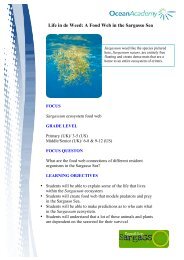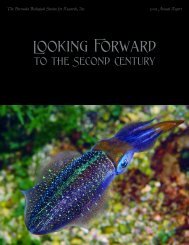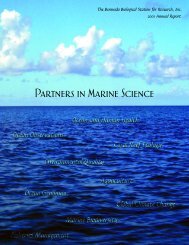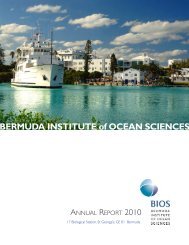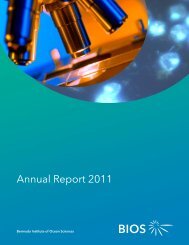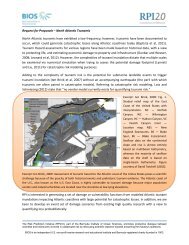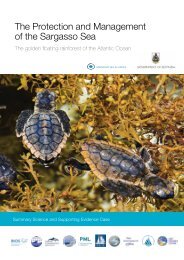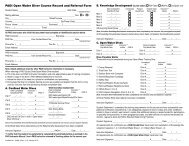BBSR 2002 Annual Report - Bermuda Institute of Ocean Sciences
BBSR 2002 Annual Report - Bermuda Institute of Ocean Sciences
BBSR 2002 Annual Report - Bermuda Institute of Ocean Sciences
You also want an ePaper? Increase the reach of your titles
YUMPU automatically turns print PDFs into web optimized ePapers that Google loves.
scallop larval rearing. Since the species found in <strong>Bermuda</strong> hadnot been cultured on a large scale elsewhere in the world,existing techniques for other scallop species were studied,modified and refined in the design <strong>of</strong> a successful protocol for<strong>BBSR</strong>’s mariculture project.As culture techniques were being developed, the facilitiesavailable at <strong>BBSR</strong> proved inadequate for controlled productionand consistent experimental results. The next stage was,therefore, the design and installation <strong>of</strong> a facility specificallyfor mariculture studies. In 1999, the Bank <strong>of</strong> <strong>Bermuda</strong>Foundation came forth with a substantial three-year grant,which generated additional matching funds from severaldonors. In <strong>2002</strong>, the Bank <strong>of</strong> <strong>Bermuda</strong> Foundation renewedits support <strong>of</strong> the project, along with funding from Mr. andMrs. Brian R. Hall, the Christian Humann Foundation andUnited Insurance Company Limited.These funds enabled the establishment <strong>of</strong> a mariculturelaboratory, where reproductive studies and larval and postlarvalrearing experiments could beconducted. The facility proved to be astepping stone in the expansion <strong>of</strong><strong>BBSR</strong>’s mariculture program, providingspace for student training andhands-on workshops, and becoming amodel for resource- and space-limitedareas, such as many islands in theCaribbean.The current facility, housed incontainers on the <strong>BBSR</strong> property,occupies approximately 1,800 squarefeet and has the capacity to produce250,000 5-millimeter “spat,” or juvenile scallops, in a sixmonthperiod. The demonstration <strong>of</strong> scallop-rearing techniquesto students is most effective in this functionalpilot-scale mariculture facility, where culture for all stages <strong>of</strong>the life cycle may be observed. Canadian trainees have spentseveral weeks at the facility for industrial placements, andundergraduates from Europe and North America have spentseveral months learning the techniques under the supervision<strong>of</strong> <strong>BBSR</strong> scientists.The mariculture project is providing additional scientificbenefits to <strong>BBSR</strong>’s research program on the connectionsbetween ocean health and human health. For example, we arecollaborating with Dr. Richard Owen <strong>of</strong> <strong>BBSR</strong>’s ecotoxicologylaboratory to develop rapid assays for shellfish, a little likeblood cholesterol tests, that show whether these organismsare being exposed to toxic insecticides.The compactness <strong>of</strong> <strong>BBSR</strong>’s relatively inexpensive mariculturefacility has proved very attractive to organizationsSCUBA surveys lasted for aperiod <strong>of</strong> eight months and gaveappalling results: Only twoscallops were found at twodifferent sites!interested in developing mariculture programs in their owncountries. This interest has led to a proposal for the transferand implementation <strong>of</strong> scallop culture technology in Cuba,initiated by the Food and Agriculture Organization <strong>of</strong> theUnited Nations. The program is scheduled to be carried out in2004/2005.On a smaller scale, other islands have shown interest inapplying mariculture technology to their own sites. Forexample, the Trade Wind Conch Farm in the Turks and CaicosIslands has received to date two shipments <strong>of</strong> juvenile scallopsfrom <strong>BBSR</strong> for grow-out trials in their bays.Perhaps most significantly, there has been considerablelocal interest in mariculture. A Bermudian fisherman was thefirst to purchase juvenile scallops from the <strong>BBSR</strong> facility and,following a short training session, is currently growing themto market size for future sales to local restaurants. This type <strong>of</strong>“extension” program was one <strong>of</strong> the first goals <strong>of</strong> the maricultureproject, where technology developed at <strong>BBSR</strong> would betransferred to the private sector inview <strong>of</strong> commercial development.The application <strong>of</strong> scientificallyderived studies to the more practicalbusiness world is the most difficultaspect <strong>of</strong> this project, but it is also thefinal step in providing continuity in amariculture operation. For thisreason, the year 2003 will be dedicatedto the economic assessment <strong>of</strong><strong>BBSR</strong>’s mariculture program.Locally, the success <strong>of</strong> theprogram can be evaluated by the productionlevel <strong>of</strong> the mariculture hatchery in 2001 and <strong>2002</strong>,averaging 80,000 scallops for each year. This production hasbeen used for experimental work in optimizing techniques,for a passive stock-enhancement program <strong>of</strong> natural populations,and finally for the re-introduction <strong>of</strong> <strong>Bermuda</strong> scallopsto local restaurant menus. <strong>BBSR</strong>’s scallops are now sold on aregular basis to several restaurants, providing an indication <strong>of</strong>demand and appreciation <strong>of</strong> this farmed seafood product.Hence, 15 years after the discussions <strong>of</strong> the <strong>BBSR</strong> longrangeplanning workshop, mariculture studies at <strong>BBSR</strong> haveshown great potential in the use <strong>of</strong> culture techniques forstock enhancement purposes, and thus the preservation <strong>of</strong>biodiversity in <strong>Bermuda</strong>’s marine fauna. They have alsoshown potential in the supply <strong>of</strong> a reliable seafood product ona resource-limited island. Furthermore, this program hasdemonstrated that sustainable environmentally friendlymariculture activities can be conducted in <strong>Bermuda</strong>, and canbe used as a model in similar regions worldwide.Left: <strong>BBSR</strong> scientists investigate <strong>Bermuda</strong>’s marine biodiversity at the south shore boiler reefs in 1933Upper right: The <strong>Bermuda</strong> scallop, or Pecten ziczac, was included in <strong>Bermuda</strong>’s Protected Species Act in 1978 after overfishingdevastated the populationLower right: Dr. Samia Sarkis, head <strong>of</strong> <strong>BBSR</strong>’s mariculture project, prepares to place Japanese pearl nets full <strong>of</strong> juvenile <strong>Bermuda</strong> scallopsinto the ocean to mature9



